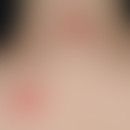Synonym(s)
DefinitionThis section has been translated automatically.
Acquired, usually non-systematic skin diseases, which are not inherited according to Mendel's laws, may manifest in a phase of exacerbation, "suddenly" along the Blaschko lines (see also ILVEN) or in other mosaic patterns (see mosaic cutaneous) (in atopic eczema, psoriasis vulgaris, dyskeratosis follicularis, lichen planus, circumscritic scleroderma, etc.).
Apparently, during embryogenesis a mutated cell clone has grown out, which represents a locus minoris resistentiae, in which the underlying disease is realized.
ClassificationThis section has been translated automatically.
Cutaneous mosaics can be divided into 2 categories:
- Epigenetic mosaics: All cells have the same genome. The influence of certain control genes gives rise to functionally different cell clones. These functional mosaics are hereditary.
- Genetic m osaics: Two or more cell populations have different genomes. These are generally not heritable. However, there are exceptions to this rule in the form of paradominant traits (see below Paradominance).
Note(s)This section has been translated automatically.
The diagnosis of genetic mosaics is facilitated by the use of modern "next generation sequencing" (NGS) methods, which can also detect low-grade mosaics. Many mosaic mutations are not detectable in the blood, but only in the affected tissue, for example the skin.
LiteratureThis section has been translated automatically.
- Al-Rohil RN et al (2014) Congenital vulnerability of cutaneous segments arising from skin mosaicism: A genetic basis for locus minoris resistentiae. Clin Dermatol 32:577-591
- Cohen J (2014) Analysis of 36 cases of Blaschkoid dyspigmentation: reading between the lines of Blaschko. Pediatric Dermatol 31:471-476
- Johnson M et al (2014) Interface dermatitis along Blaschko lines. J Cutan Pathol doi: 10.1111/cup.12412
Incoming links (1)
Blaschko-linear inflammatory dermatoses;Outgoing links (10)
Atopic dermatitis (overview); Blaschko lines; Circumscribed scleroderma; Dyskeratosis follicularis; Epigenetics; Ilven; Lichen planus classic type; Mosaic cutaneous; Paradominance; Psoriasis vulgaris;Disclaimer
Please ask your physician for a reliable diagnosis. This website is only meant as a reference.









